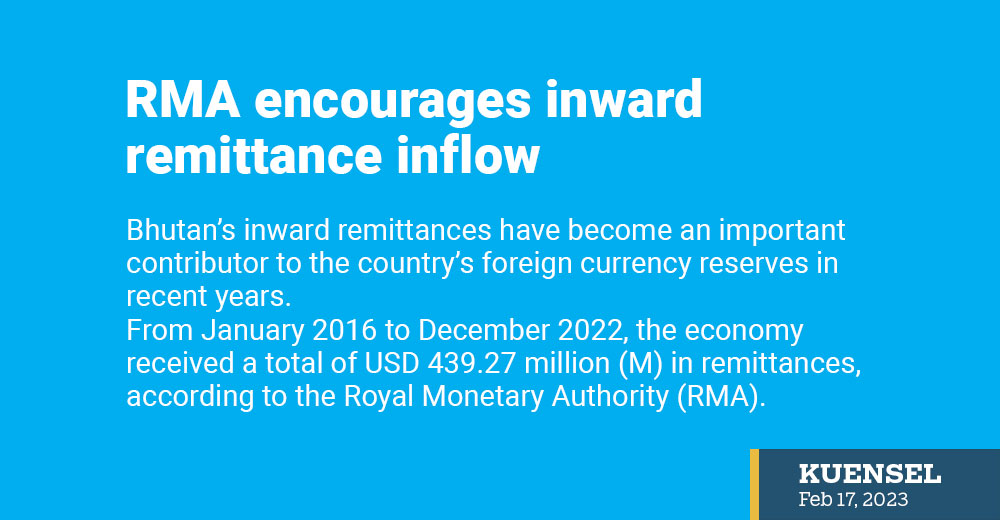… 2 percent incentive to continue until December this year
Thukten Zangpo
Bhutan’s inward remittances have become an important contributor to the country’s foreign currency reserves in recent years.
From January 2016 to December 2022, the economy received a total of USD 439.27 million (M) in remittances, according to the Royal Monetary Authority (RMA).
Its contribution to convertible currency inflow in the country was 14 percent as of November last year.
In 2020 and 2021, it accounted for 21 percent and 23 percent, respectively.
The country received USD 75.10M as remittances in 2022, USD 102.26M in 2021 and USD 112.97M in 2020.
Remittance plays a crucial role at both macro and micro levels.
At micro-level, remittances add to household income at home, help in improving the standard of living, and promote savings and investment.
At the macro-level, inward remittances improve the country’s balance of payment position; helps pay import bills, builds foreign currency reserves, helps debt servicing and boosts economic growth.
The countries like Philippines, Nepal, Bangladesh, and India were thriving on inward remittances.
“We can sell the remittances denominated in USD to buy Indian Rupee (INR) during the INR crisis from Asian Development Bank and World Bank,” a RMA official said.
He added that the remittances received contribute to the banks’ deposits, which can be re-lent in the economy for credit growth.
To encourage inward remittances into the country, the RMA launched RemitBhutan, a platform, an account opening facility for non-resident Bhutanese in 2016.
The Authority launched incentives on inward remittances of 1 percent in 2021 for Bhutanese who live, work, or study overseas to offset the transaction costs while sending money to their personal accounts or to their family members in Bhutan.
From July 1 last year, the incentive was increased from 1 to 2 percent until December 31 last year.
The Authority announced yesterday that the 2 percent incentive scheme will be extended until December 30 this year. Inward remittances received from January 1, this year will be eligible for the scheme.
The beneficiaries will receive a cash incentive of 2 percent upon converting the remitted amount into Ngultrum using the prevailing exchange rates through the banking channels and the international money transfer operators, according to the RMA.
However, the incentive will not be applicable for remittances received for the purpose of foreign direct investments, donations, and trade, including remittances received in favour of non-governmental organisations, civil society organisations, and companies.
Since the initiation of the scheme, a total of USD 130.5M have been received.
The Authority facilitated Nu 54.84M as incentives to beneficiaries from 19 dzongkhags with Nu 47.88M disbursed in Thimphu, the highest.
As per a study by the RMA, it was found that the monetary incentive helped ensure remittance flows to be received through formal channels.
The economy received three percent higher inward remittance as compared to the estimated remittance value projected at USD 127.1M.
Another assessment was carried out to analyse the impact of the monetary incentive to finance the balance of payment requirements with India.
An RMA assessment found that inward remittances helped finance the balance of payment requirements with India amounting to INR 10.01B (30 percent of the past three years’ average current account deficit with India of INR 29.94B) at a cost of Nu 54.79M (total incentive amount facilitated).
This was a decrease by Nu 62.67M as compared to the current INR borrowing cost on an average of 3.9 to 5 percent interest cost of INR 117.46M.
The RMA also found that the incentive support scheme helped to reduce the cost of remitting USD 200 from Australia to Bhutan by 2.14 percent, a decrease by 4.23 percent of the principal amount in 2021 to 2.09 percent of the principal amount in 2022.
This was 3.8 percent lower than the average cost of remitting USD 200 from Australia which stood at 5.94 percent as per the September 2022 remittance prices worldwide report published by World Bank.
RMA’s plan is to add schemes on the Bhutanese abroad to invest in Bhutan through buying of shares, and initiate provident fund schemes.
A total of 2,733 non-resident Bhutanese foreign currency and Ngultrum accounts were opened through the RemitBhutan platform from which 328 opened from January 22 to January 23.
The remittance inflow in the country can be done through nine channels—Bhutan Post’s Western Union and EuroGiro, T-Bank’s T-Pay remit and Prabhu Money Transfer, Bhutan National Bank’s MoneyGram and Ria Money Transfer, Bank of Bhutan’s Ria Money Transfer and BoBit, and Bank Transfer (SWIFT).


